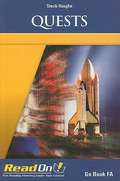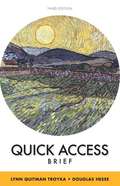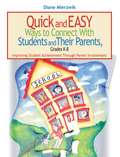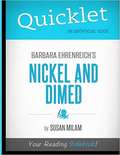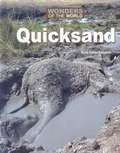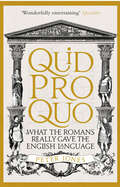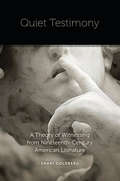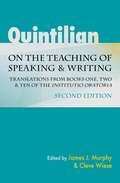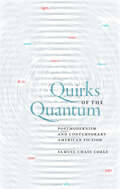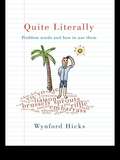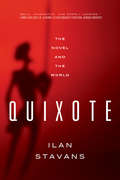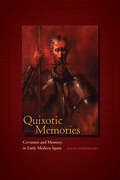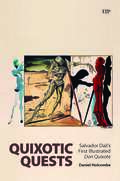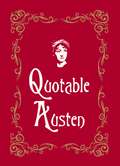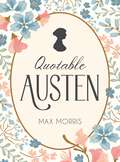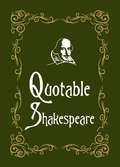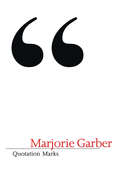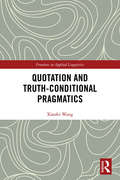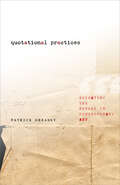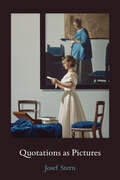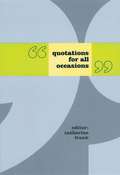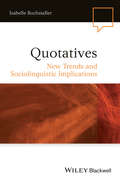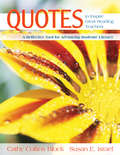- Table View
- List View
Quests (Read On! Go Book FA)
by Harcourt Achieve20 short stories designed to increase reading comprehension.
Quick Access Brief
by Lynn Quitman Troyka Douglas HesseTroyka and Hesse give practical advice to students about the writing they will do in composition courses, in other classes, and in the world beyond. Offering instructors a full range of choices in handbooks.
Quick and Easy Ways to Connect with Students and Their Parents, Grades K-8: Improving Student Achievement Through Parent Involvement
by Diane MierzwikThe research is indisputable. The more involved parents are with their child’s education, the more successful that child will be in school. Therefore, finding ways as a teacher to reach out to students and their parents is crucial in improving academic performance.Quick and Easy Ways to Connect With Students and Their Parents, Grades K-8 provides strategies to enrich the classroom environment, motivate students, and improve communication with parents. Supplying numerous sample forms, documents, and letters that teachers can use or adapt for their own purposes, author Diane Mierzwik offers simple, classroom-tested methods for building relationships with students and their parents.Designed for both beginning and experienced teachers, this hands-on guidebook includes information on:• Facilitating constructive parent-teacher conferences• Preparing for Back-to-School nights• Reaching out to uninvolved parents• Talking to parents about troubled students• Motivating even the most difficult students• Using e-mail as a communication tool and other time-saving tipsThe activities, suggestions, and techniques in this book can help any teacher make a substantive impact on the lives of students.
Quicklet: Barbara Ehrenreich's Nickel and Dimed
by The Quicklet TeamBarbara Ehrenreich's Nickel and Dimed has sold more than 1.5 million copies since its publication in 2001. It is required reading in many high school and college classrooms. The book has been translated into several languages. It has recently become available as an ebook. Nickel and Dimed received The 2001 Los Angeles Times Book Prize for Best Current Interest book Joan Holden wrote a play based on the characters found in Nickel and Dimed. Richard Brick and Ira Deutchman are developing a movie based on Nickel and Dimed. Mr. Brick is best known as the co-producer of several Woody Allen movies. He also worked with the late Peter Jennings.
Quicksand
by Kris HirschmannDeath by quicksand is a popular subject in movies and TV shows. Real-life quicksand is not as deadly as the fictional variety -- but it does exist, and in the right circumstances it can kill. This book explains what quicksand is, how it forms, and what happens if a person or animal falls in. It also recounts some true quicksand disasters.
Quicksolve Whodunit Puzzles: Challenging Mini-mysteries
by Jim Sukach Lucy CorvinoHelp Dr.Quicksolve solve murders, burglaries, frauds, kidnappings, and other mysteries. By reading each puzzle carefully, paying attention to detail and what people say, you'll be able to catch the crooks just as quickly as the ace detective, and you'll have a lot of fun doing it.
Quid Pro Quo: What the Romans Really Gave the English Language (Classic Civilisations Ser. #3)
by Peter JonesPeter Jones takes the reader on a fascinating journey along the highways and byways of Roman life and culture, telling the amazing stories behind the original Latin meanings and uses of hundreds of our everyday words. Taking in every aspect of the ancient world, including science, religion, military matters, politics and literature, Jones shows just how much the English language owes to the ancient Romans and the role Latin has played in the creation of our vast vocabulary.
Quiet Testimony: A Theory of Witnessing from Nineteenth-Century American Literature
by Shari GoldbergThe nineteenth century was a time of extraordinary attunement to the unspoken, the elusively present, and the subtly haunting. Quiet Testimony finds in such attunement a valuable rethinking of what it means to encounter the truth. It argues that four key writers—Emerson, Douglass, Melville, and Henry James—open up the domain of the witness by articulating quietude’s claim on the clamoring world.The premise of quiet testimony responds to urgent questions in critical theory and human rights. Emerson is brought into conversation with Levinas, and Douglass is considered alongside Agamben. Yet the book is steeped in the intellectual climate of the nineteenth century, in which speech and meaning might exceed the bounds of the recognized human subject. In this context, Melville’s characters could read the weather, and James’s could spend an evening with dead companions.By following the path by which ostensibly unremarkable entities come to voice, Quiet Testimony suggests new configurations for ethics, politics, and the literary.
Quintilian On The Teaching Of Speaking And Writing: Translations From Books One, Two And Ten Of The Institutio Oratoria (Landmarks In Rhetoric And Public Address)
by James J. Murphy Hugh C. WieseQuintilian on the Teaching of Speaking and Writing, edited by James J. Murphy and Cleve Wiese, offers scholars and students insights into the pedagogies of Marcus Fabius Quintilianus (ca. 35–ca. 95 CE), one of Rome’s most famous teachers of rhetoric. Providing translations of three key sections from Quintilian’s important and influential Institutio oratoria (Education of the Orator), this volume outlines the systematic educational processes that Quintilian inherited from the Greeks, foregrounding his rationale for a rhetorical education on the interrelationship between reading, speaking, listening, and writing, and emphasizing the blending of moral purpose and artistic skill. Translated here, Books One, Two, and Ten of the Institutio oratoria offer the essence of Quintilian’s holistic rhetorical educational plan that ranges from early interplay between written and spoken language to later honing of facilitas, the readiness to use language in any situation. Along with these translations, this new edition of Quintilian on the Teaching of Speaking and Writing contains an expanded scholarly introduction with an enhanced theoretical and historical section, an expanded discussion of teaching methods, and a new analytic guide directing the reader to a closer examination of the translations themselves. A contemporary approach to one of the most influential educational works in the history of Western culture, Quintilian on the Teaching of Speaking and Writing provides access not only to translations of key sections of Quintilian’s educational program but also a robust contemporary framework for the training of humane and effective citizens through the teaching of speaking and writing.
Quirks of the Quantum: Postmodernism and Contemporary American Fiction (Cultural Frames, Framing Culture)
by Samuel Chase CoaleEpisodic and disconnected, much of postmodern fiction mirrors the world as quantum theorists describe it, according to Samuel Chase Coale. In Quirks of the Quantum, Coale shows how the doubts, misgivings, and ambiguities reflected in the postmodern American novel have been influenced by the metaphors and models of quantum theory. Coale explains the basic facets of quantum theory in lay terms and then applies them to a selection of texts, including Don DeLillo's Underworld, Joan Didion's Democracy, and Thomas Pynchon's Against the Day. Using a new approach to literature and culture, this book aims to bridge the gap between science and the humanities by suggesting the many areas where they connect.
Quite Literally: Problem Words and How to use Them
by Wynford HicksThis is a guide to English usage for readers and writers, professional and amateur, established and aspiring, formal trainees and those trying to break in; students of English, both language and literature, and their teachers. In Quite Literally, Wynford Hicks answers questions like: What's an alibi, a bete noire, a celibate, a dilemma? Should underway be two words? Is the word 'meretricious' worth using at all? How do you spell realise - with an s or a z - and should bete be bête? Should you split infinitives, end sentences with prepositions, start them with conjunctions? What about four-letter words, euphemisms, foreign words, Americanizms, clichés, slang, jargon? And does the Queen speak the Queen's English? The advice given can be applied to both formal speech - what is carefully considered, broadcast, presented, scripted or prepared for delivery to a public audience - and will even enhance your everyday languange too! Practical and fun, whether to improve your writing for professional purposes or simply enjoy exploring the highways and byways of English usage, readers from all walks of life will find this book both invaluable and enjoyable.
Quixote: The Novel and the World
by Ilan StavansA groundbreaking cultural history of the most influential, most frequently translated, and most imitated novel in the world. The year 2015 marks the four hundredth anniversary of the publication of the complete Don Quixote of La Mancha--an ageless masterpiece that has proven unusually fertile and endlessly adaptable. Flaubert was inspired to turn Emma Bovary into "a knight in skirts." Freud studied Quixote's psyche. Mark Twain was fascinated by it, as were Kafka, Picasso, Nabokov, Borges, and Orson Welles. The novel has spawned ballets and operas, poems and plays, movies and video games, and even shapes the identities of entire nations. Spain uses it as a sort of constitution and travel guide; and the Americas were conquered, then sought their independence, with the knight as a role model. In Quixote, Ilan Stavans, one of today's preeminent cultural commentators, explores these many manifestations. Training his eye on the tumultuous struggle between logic and dreams, he reveals the ways in which a work of literature is a living thing that influences and is influenced by the world around it.
Quixotic Memories: Cervantes and Memory in Early Modern Spain (Toronto Iberic)
by Julia DominguezThe work of Miguel de Cervantes – one of the most influential writers in early modern Europe – is a reflection of the rich culture of memory in which it was created. More than a theme, memory is a system of understanding in Cervantes’s world, resulting from the major social, religious, and economic changes that epitomized Renaissance humanist culture and that informed the transition to modernity. Quixotic Memories offers insight into the plurality and complexity of memory and demonstrates how it plays an exceptionally critical role in Cervantes’s Don Quixote. It acknowledges Cervantes’s transition into modernity as he engaged with theories of memory that were developed in classical antiquity and adapted to the specific circumstances of his own time. Julia Domínguez explores the many spaces that memory created for itself in early modern Spain, particularly in the fields of philosophy, medicine, rhetoric, mnemotechnics, the visual arts, and pedagogy. Engaging with primary and archival sources, Quixotic Memories provides a new reading of Cervantes’s famous novel by tracing the socio-historical and cultural prominence of memory throughout the author’s lifetime.
Quixotic Quests: Salvador Dalí’s First Illustrated <em>Don Quixote</em> (Toronto Iberic)
by Daniel HolcombeSalvador Dalí illustrated Miguel de Cervantes’s Don Quixote for the first time while living in exile in the United States in the 1940s, collaborating with Random House to produce a special edition that was published in 1946. Quixotic Quests examines the material history of this 1946 edition by bridging art history, book history, literature, and narratology, while exploring Dalí’s role as its illustrator and the reception of both by mid-century popular culture, art historians, and literary scholars. Positing that much of Dalí’s life was quixotic in nature, the book investigates his quest to illustrate the novel with an unprecedented level of pictorial didacticism, despite challenges that the artist and Random House faced during and after the Second World War. It details his resolute passion to integrate surrealism with classicism, visual art with narrative, sexuality with sublimation, and privacy with public persona. Contrasting Dalí’s visual achievements with other artists and stylistic movements, Quixotic Quests sheds new light on the niche that Dalí created for himself as a surrealist illustrator of Don Quixote. Consulting his autobiographical narratives, the book analyses Dalí’s unique artistic contributions to the four-hundred-year print history of the novel, while emphasizing the artist’s heartfelt appreciation and respect for his book illustrations.
Quotable Austen (Quotable Ser.)
by Max MorrisThese entertaining collections gather together the wisest and wittiest quotations from some of Britain’s best-loved historical figures. Packed with humorous, perceptive and compelling quotes, they are sure to delight readers everywhere.
Quotable Austen: Memorable Quotes from Our Favourite Writer
by Max MorrisCelebrating Jane Austen's 250th birthday, this book is a charming collection of notable quotes from her most celebrated nineteenth-century novels A fine collection of the wisest and wittiest quotes from one of the most beloved and prominent British writers of all time, this book is sure to win you over with Jane Austen's ability for turning typical people and mundane events into charming and relatable stories. With over 140 quotes from her completed novels - Sense and Sensibility, Pride and Prejudice, Mansfield Park, Emma, Northanger Abbey and Persuasion - this book is the perfect opportunity for readers to immerse themselves in the refinement of the Regency era.Austen was well known for her astute social observation and keen insight into the lives of women in the early nineteenth century. This collection will urge you to:- Ardently admire and love- Feel the pangs of disappointed love - Find comfort in words of wisdom- Acquaint yourself with the refinements of polished society- Learn witty comebacks to leave your friends speechlessAfter all, it is a truth universally acknowledged that this would be the ultimate gift for Janeites and Austenites.
Quotable Shakespeare (Quotable Ser.)
by Max MorrisThis entertaining collection gathers together William Shakespeare's wisest and wittiest quotations. Quotable Shakespeare proves that brevity is the soul of wit and is sure to delight all lovers of the Bard's uniquely perceptive and influential works.
Quotable Shakespeare (Quotable Ser.)
by Max MorrisThis entertaining collection gathers together William Shakespeare's wisest and wittiest quotations. Quotable Shakespeare proves that brevity is the soul of wit and is sure to delight all lovers of the Bard's uniquely perceptive and influential works.
Quotation Marks
by Marjorie GarberWritten with characteristic verve, Quotation Marks considers, among other subjects, how we depend upon the most quotable men and women in history, using great writers to bolster what we ourselves have to say. The entertaining turns and reversals of Marjorie Garber's arguments offer the rare pleasure of a true essayist.
Quotation and Truth-Conditional Pragmatics (Frontiers in Applied Linguistics)
by Xiaofei WangIn the past decades, quotation theories have developed roughly along three lines—quotation types, meaning effects, and theoretical orientations toward the semantics/pragmatics distinction. Currently, whether the quoted expression is truth-conditionally relevant to the quotational sentence, and if there is a truth-conditional impact, whether it is generated via semantic or pragmatic processes, have become the central concerns of quotation studies. In this book, quotation is clearly defined for the first time as a constituent embedded within yet distinctive from the quotational sentence. Also, as the first monograph to address the semantics/pragmatics boundary dispute over quotation, it argues that the semantic content of quotation amounts to its contribution to the intuitive truth-conditional content of the quotational utterance via two modes of presentation, which are incarnated in the functioning of quotation marks and manifested as use and mention. The use/mention-based analysis in this book can shed light on the semantic theorizing of other metalinguistic phenomena, while the semantics/pragmatics perspective will provide methodological implications for other relevant studies. The new conception of quotation and thought-provoking analysis on use/mention, truth-conditional pragmatics, and the semantics/pragmatics boundary in this book will appeal to scholars and students in philosophy of language and linguistics. It will also serve as a clear guide to the current state of quotation studies and how to formulate a semantic theory of quotation.
Quotational Practices: Repeating the Future in Contemporary Art
by Patrick GreaneyLiterature and art have always depended on imitation, and in the past few decades quotation and appropriation have become dominant aesthetic practices. But critical methods have not kept pace with this development. Patrick Greaney reopens the debate about quotation and appropriation, shifting away from naïve claims about the death of the author. In interpretations of art and literature from the 1960s to the present, Quotational Practices shows how artists and writers use quotation not to undermine authorship and originality, but to answer questions at the heart of twentieth-century philosophies of history.Greaney argues that quotation is a technique employed by art and philosophy to build ties to the past and to possible futures. By exploring quotation&’s links to gender, identity, and history, he offers new approaches to works by some of the most influential modern and contemporary artists, writers, and philosophers, including Walter Benjamin, Guy Debord, Michel Foucault, Marcel Broodthaers, Glenn Ligon, Sharon Hayes, and Vanessa Place.Ultimately, Quotational Practices reveals innovative perspectives on canonical philosophical texts as well as art and literature in a wide range of genres and mediums—from concrete poetry and the artist&’s book to performance, painting, and video art.
Quotations as Pictures
by Josef SternThe proposal of a semantics for quotations using explanatory notions drawn from philosophical theories of pictures. In Quotations as Pictures, Josef Stern develops a semantics for quotations using explanatory notions drawn from philosophical theories of pictures. He offers the first sustained analysis of the practice of quotation proper, as opposed to mentioning. Unlike other accounts that treat quotation as mentioning, Quotations as Pictures argues that the two practices have independent histories, that they behave differently semantically, that the inverted commas employed in both mentioning and quotation are homonymous, that so-called mixed quotation is nothing but subsentential quotation, and that the major problem of quotation is to explain its dual reference or meaning—its ordinary meaning and its metalinguistic reference to the quoted phrase attributed to the quoted subject. Stern argues that the key to understanding quotation is the idea that quotations are pictures or have a pictorial character. As a phenomenon where linguistic competence meets a nonlinguistic symbolic ability, the pictorial, quotation is a combination of features drawn from the two different symbol systems of language and pictures, which explains the exceptional and sometimes idiosyncratic data about quotation. In light of this analysis of verbal quotation, in the last chapters Stern analyzes scare quotation as a nonliteral expressive use of the inverted commas and explores the possibility of quotation in pictures themselves.
Quotations for All Occasions
by Catherine FrankOn the most important occasions of our lives, we often find ourselves at a loss for words; when we want to console, celebrate, explain, inspire, or thank, we end up repeating such uninspiring, uninformative phrases as "Words cannot express how I feel." To help us find the right words, Catherine Frank has compiled this handy compendium of quotations that capture the mundane and the magnificent, the everyday and extraordinary moments of our lives.The three sections of the book cover 150 occasions. "Every Year" offers quotations on all the special dates in the calendar from New Year's Day to New Year's Eve, including Martin Luther King Day, Valentine's Day, Ramadan, Mother's Day, Thanksgiving, Kwanzaa, and Christmas. "Occasionally" presents quotations on such occasions as giving a speech, having an interview, becoming a parent, getting engaged, welcoming someone, and saying goodbye. "Once in a Lifetime" provides quotations on such momentous events as confirmation, coming out, turning 16, graduation, and retirement. A sampling: Plato, John Donne, and Woody Allen give their words of wisdom on death. Betty Ford writes eloquently on recovery. Martina Navratilova ruminates on her first sexual encounter... and Holden Caufield on his. Ralph Waldo Emerson, Mark Twain, and Frederick Douglass ponder Independence Day. Amy Tan reflects on the meaning of the Chinese New Year. Samuel Taylor Coleridge and Susan Sontag offer poignant descriptions of pain and illness.Whether you are offering consolation or congratulations, condolences or confessions, Quotations for All Occasions has the perfect words for every occasion.
Quotatives
by Isabelle BuchstallerQuotatives considers the phenomenon "quotation" from a wealth of perspectives. It consolidates findings from different strands of research, combining formal and functional approaches for the definition of reported discourse and situating the phenomenon in a broader typological and sociolinguistic perspective.Provides an interface between sociolinguistic research and other linguistic disciplines, in particular discourse analysis, typology, construction grammar but also more formal approachesIncorporates innovative methodology that draws on discourse analytic, typological and sociolinguistic approachesInvestigates the system both in its diachronic development as well as via cross-variety comparisonsPresents careful definition of the envelope of variation and considers alternative definitions of the phenomenon "quotation"Empirical findings are reported from distribution and perception data, which allows comparing and contrasting perception and reality
Quotes to Inspire Great Reading Teachers: A Reflective Tool for Advancing Students' Literacy
by Cathy Collins Block Susan E. IsraelA year's worth of thought-provoking quotations will inspire you to reflect on the way you teach and provide you with tools to inspire your students, too!
